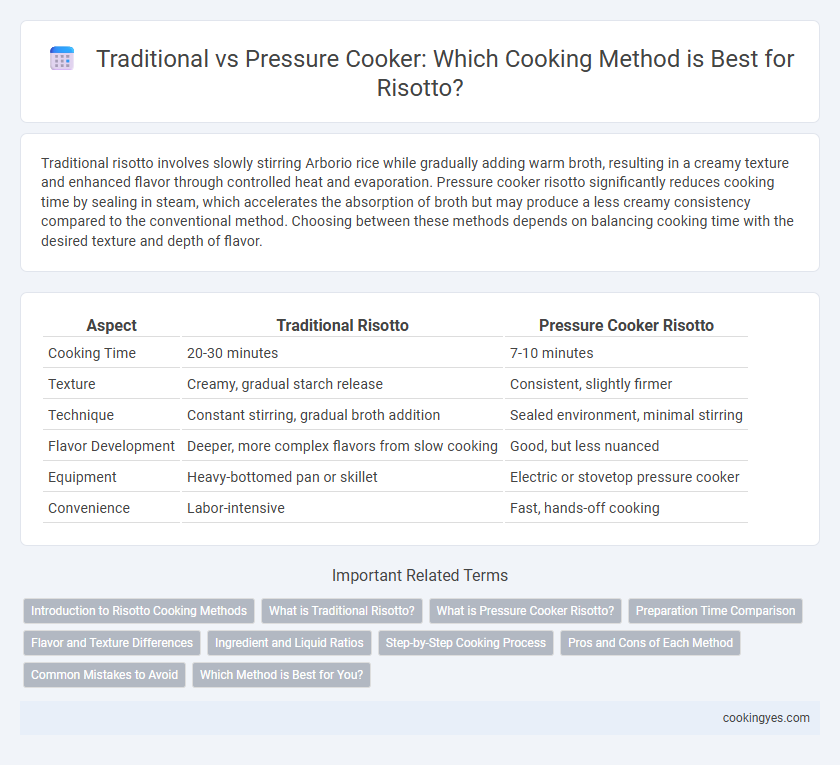Traditional risotto involves slowly stirring Arborio rice while gradually adding warm broth, resulting in a creamy texture and enhanced flavor through controlled heat and evaporation. Pressure cooker risotto significantly reduces cooking time by sealing in steam, which accelerates the absorption of broth but may produce a less creamy consistency compared to the conventional method. Choosing between these methods depends on balancing cooking time with the desired texture and depth of flavor.
Table of Comparison
| Aspect | Traditional Risotto | Pressure Cooker Risotto |
|---|---|---|
| Cooking Time | 20-30 minutes | 7-10 minutes |
| Texture | Creamy, gradual starch release | Consistent, slightly firmer |
| Technique | Constant stirring, gradual broth addition | Sealed environment, minimal stirring |
| Flavor Development | Deeper, more complex flavors from slow cooking | Good, but less nuanced |
| Equipment | Heavy-bottomed pan or skillet | Electric or stovetop pressure cooker |
| Convenience | Labor-intensive | Fast, hands-off cooking |
Introduction to Risotto Cooking Methods
Traditional risotto cooking requires slow simmering and constant stirring to release starch from Arborio rice, creating a creamy texture. Pressure cooker methods significantly reduce cooking time while still allowing the rice to absorb flavors, though they may result in a less creamy consistency compared to the classic technique. Choosing between these methods depends on balancing time efficiency with authentic texture and flavor development in risotto preparation.
What is Traditional Risotto?
Traditional risotto involves slowly cooking Arborio or Carnaroli rice in a broth while continuously stirring to release the starch, creating a creamy texture. This method requires gradual addition of warm stock and constant attention over 18-20 minutes to achieve the perfect al dente consistency. Pressure cooker risotto speeds up the process but often sacrifices the signature creaminess and nuanced flavor developed through the gradual cooking and stirring technique of traditional risotto.
What is Pressure Cooker Risotto?
Pressure cooker risotto is a modern cooking method that significantly reduces cooking time by using high-pressure steam to cook the rice quickly and evenly. Unlike traditional risotto, which requires constant stirring and gradual addition of broth, pressure cooker risotto allows for a more hands-off approach while still achieving a creamy texture and rich flavor. This technique maintains the essential characteristics of classic risotto with enhanced convenience and efficiency, making it ideal for busy home cooks.
Preparation Time Comparison
Traditional risotto cooking requires about 18 to 20 minutes of constant stirring to achieve the creamy texture, while pressure cooker methods reduce preparation time significantly to approximately 7 to 10 minutes by using high-pressure steam. The pressure cooker accelerates the absorption of liquids and softens the rice grains faster, making it an efficient choice for quick meals without compromising the dish's characteristic creaminess. Home cooks seeking time-saving techniques benefit from the pressure cooker's ability to streamline risotto preparation without sacrificing flavor or texture.
Flavor and Texture Differences
Traditional risotto cooking offers a creamy texture and nuanced flavors through gradual liquid absorption and constant stirring, allowing rice to release its starch naturally. Pressure cooker risotto accelerates the process by trapping steam, resulting in a firmer texture and less complex flavor development due to reduced stirring and shorter cooking time. Choosing between methods depends on desired texture: traditional for rich creaminess and depth, pressure cooker for speed and convenience with slightly less flavor complexity.
Ingredient and Liquid Ratios
Traditional risotto recipes require a slow addition of broth with a 1:4 rice-to-liquid ratio to achieve creamy texture, while pressure cookers use a reduced liquid amount, around 1:2.5, due to sealed cooking conditions that minimize evaporation. Arborio or Carnaroli rice maintains optimal starch release in both methods, but pressure cooking demands precise measurement to prevent undercooking or mushiness. Adjusting liquid ratios according to cooking technique ensures proper consistency and flavor absorption in risotto preparation.
Step-by-Step Cooking Process
Traditional risotto cooking requires slow, gradual addition of warm broth with constant stirring to release the rice's starch, creating a creamy texture over 18-20 minutes. Pressure cooker risotto significantly reduces cooking time to 7-10 minutes by combining broth and rice simultaneously and using high pressure, but it may result in less control over texture and slight reduction in creaminess. Both methods start with toasting the rice in fat and sauteing aromatics, but the pressure cooker streamlines the gradual liquid addition and stirring phases inherent to the traditional technique.
Pros and Cons of Each Method
Traditional risotto cooking involves slow, incremental addition of broth and constant stirring, which enhances the creamy texture and depth of flavor but requires significant attention and time. Pressure cooker risotto significantly reduces cooking time and simplifies the process by combining all ingredients and cooking under high pressure, though it may sacrifice some textural nuance and the gradual development of flavors. Home cooks must balance the traditional method's rich, authentic taste against the pressure cooker's convenience and speed when choosing the optimal approach.
Common Mistakes to Avoid
Using a pressure cooker for risotto often leads to overcooked rice and loss of the creamy texture typical of traditional stovetop methods, making it crucial to avoid excessive cooking times. Common mistakes include not stirring frequently during traditional stovetop cooking, which can cause uneven cooking and sticking, and adding all the broth at once, reducing the gradual absorption key to perfect risotto. Ensuring the correct rice-to-liquid ratio and maintaining consistent heat are essential for both methods to achieve the authentic creamy risotto texture.
Which Method is Best for You?
Traditional risotto cooking requires slow stirring and gradual broth addition, allowing optimal starch release for creamy texture, ideal for those valuing authenticity and control. Pressure cookers significantly reduce cooking time while maintaining flavor and creaminess, suited for busy cooks seeking convenience without sacrificing quality. Choosing between methods depends on your time availability and preference for hands-on preparation versus efficiency.
Traditional vs Pressure cooker for cooking method Infographic

 cookingyes.com
cookingyes.com